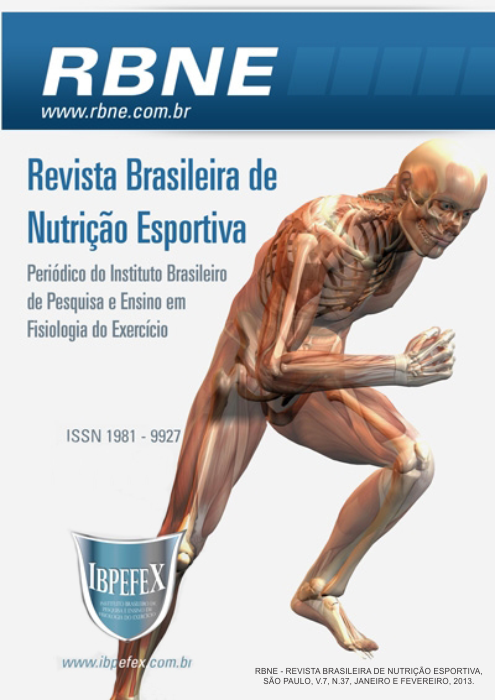Influence of feeding behavior and volume in practice of tennis on the anthropometric profile
Abstract
Introduction: Tennis is a sport that has character intermittent explosive movements alternating high intensity and short duration. It has numerous benefits to physical and mental health. Among the benefits, the change in body composition may be related not only to the practice of tennis, but also in feeding behavior. Objective: To analyze the influence of practice time, the volume of weekly practice, feeding behavior and age in arm muscle circumference and percentage of body fat amateur tennis players -and to assess the relationship between these variables. Materials and Methods: We assessed 40 amateur tennis players adult males. A questionnaire was given food, questions about time and volume of practice. With aidof a scale was measured total body mass, measured with a caliper and the skin folds with a ribbon inelastic height and arm circumference. Results: The main findings of this study were lower arm muscle circumference in subjects with longer practice. The age variable was correlated with time and volume of practice. The fat percentage was higher in older individuals. Discussion: A smaller arm muscle circumference of individuals with longer practice could be at excess lean mass hindering the realization of themovements with power. The change in body composition with aging may explain a greater percentage of fat in older individuals. Conclusion: Further studies can be conducted in order to assess other factors that may interfere with the body composition and eating behavior.
References
-Arruda, E.L.M.; Lopes, A.S. Gordura corporal, nível de atividade física e hábitos alimentares de adolescentes da região serrana de Santa Catarina, Brasil. Revista Brasileira de Cineantropometria & Desempenho Humano. Santa Catarina. Vol. 9. Num. 1. 2007. p. 05-11.
-Calloway, D.H.; Zani, E. Energy requirements and energy expenditure of elderly men. The American Journal of Clinical Nutrition. Vol. 33. Num. 10. 1980. p. 2088-2092.
-Durnin, J.V.G.A.; Womersley, J. Body fat assessed from total body density and its estimation from skinfold thickness: measurements on 481 men and women aged from 16 to 72 years. British Journal of Sports Medicine. Vol. 32. Num. 1. 1974. p. 77-97.
-Fernandez, J; Mendez-Villanueva, A.; Pluim, B.M. Intensity of tennis match play. British Journal of Sports Medicine. Espanha. Vol. 40. Num. 5. 2006. p. 387-391.
-Gomes, R.V.; Ribeiro, S.M.L.; Veibig, R.F.; Aoki, M.S. Consumo Alimentar e Perfil Antropométrico de Tenistas Amadores e Profissionais. Revista Brasileira de Medicina do Esporte. São Paulo. Vol. 15. Num. 6. 2009. p. 436-440.
-Groppel, J.; DiNubile, N. Tennis: for the health of it! Physician and Sports medicine. Estados Unidos. Vol. 37. Num. 2. 2009. p. 50-50.
-Guedes, E.J.M.; Barbieri, D.F.; Fiabane, F. Lesões em tenistas competitivos. Revista Brasileira de Ciências do Esporte. Campinas. Vol. 31. Num. 3. 2010. p. 217-229.
-Gurney, J.M., Jelliffe, D.B. Arm anthropometry in nutritional assessment: nomogram for rapid calculation of muscle circumference and cross-sectional muscle and fat areas. The American Journal of Clinical Nutrition. Estados Unidos. Vol. 26. Num. 9. 1973. p. 912-915.
-Marks, B.L. Health benefits for veteran (senior) tennis players. British Journal of Sports Medicine. Estados Unidos. Vol. 40. Num. 5. 2006. p. 469-476.
-Pereira, C.F. Perfil corporal de tenistas participantes do campeonato brasileiro de tênis, ambos os sexos, categoria 16 anos: um relato cineantropométrico. Revista Treinamento Desportivo. Vol. 6. Num. 1. 2001. p. 53-71.
-Pluim, B.M.; Staal, J.B.; Marks,B.L.; Miller, S.; Miley, D. Health benefits of tennis. British Journal of Sports Medicine. Amsterdã. Vol. 41. Num. 1. 2007. p. 760-768.
-Sánchez-Muñoz, C.; Sanz, D.; Zabala, M. Anthropometric characteristics, body composition and somatotype of elite junior tennis players. British Journal of Sports Medicine. Granada. Vol. 41. Num. 11. 2007. p. 793-799.
-Silva, T.A.A.; Junior, A.F.; Pinheiro, M.M.; Szejnfeld, V.L. Sarcopenia associada ao envelhecimento: aspectos etiológicos e opções terapêuticas. Revista Brasileira de Reumatologia. São Paulo. Vol. 46. Num. 6. 2006. p. 391-397.
-Vaughan, L. Zurlo, F. Ravussin, E. Aging and energy expenditure. The American Journal of Clinical Nutrition. Arizona. Vol. 53. Num. 4. 1991. p. 821-825
Authors who publish in this journal agree to the following terms:
- Authors retain the copyright and grant the journal the right of first publication, with work simultaneously licensed under the Creative Commons Attribution License BY-NC which allows the sharing of the work with acknowledgment of the authorship of the work and initial publication in this journal.
- Authors are authorized to enter into additional contracts separately for non-exclusive distribution of the version of the work published in this journal (eg, publishing in institutional repository or book chapter), with acknowledgment of authorship and initial publication in this journal.
- Authors are allowed and encouraged to post and distribute their work online (eg, in institutional repositories or on their personal page) at any point before or during the editorial process, as this can bring about productive change as well as increase impact and impact. citation of published work (See The Effect of Free Access).






